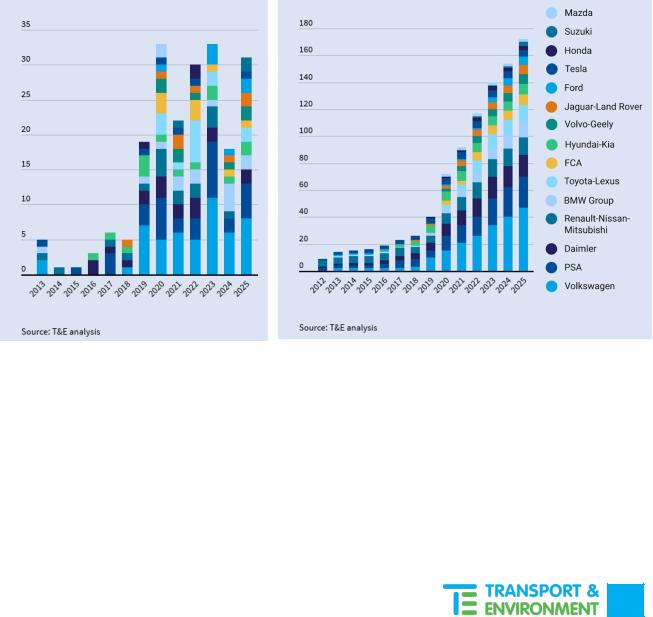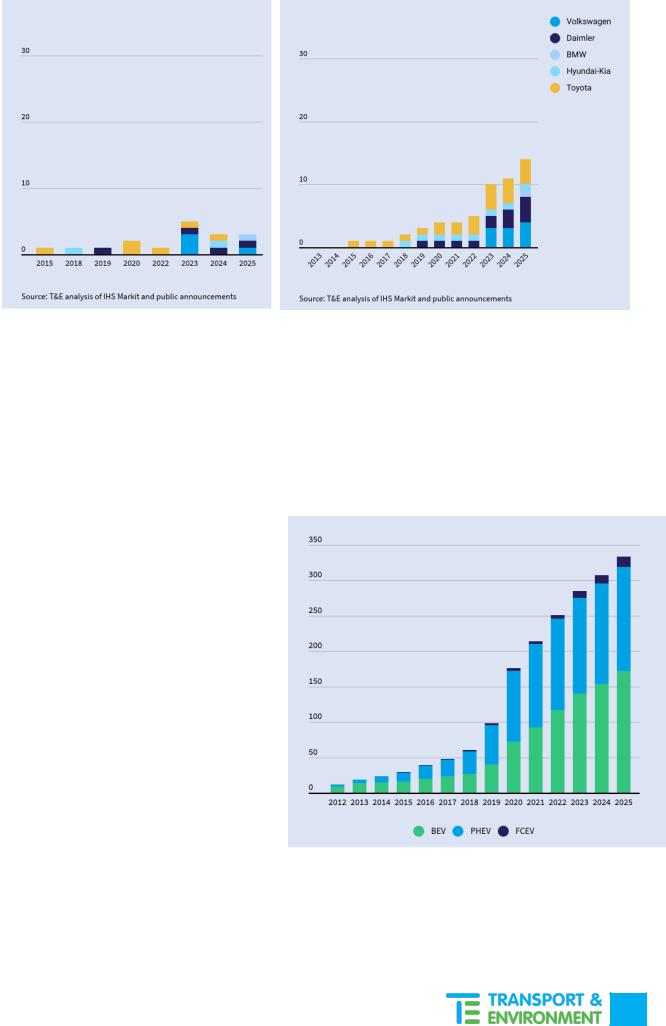
- •Summary
- •1. Introduction
- •2. Carmakers’ EV plans across Europe: 2019 to 2025
- •2.1. Forecast data on EV production
- •2.2. EV models coming to the market up to 2025
- •2.3. Shift in production volumes
- •2.3.1. Market evolution
- •2.3.2. FCEV production
- •2.3.3. CNG production
- •2.3.4. Full Hybrids
- •2.4. Individual OEM production plans
- •2.5. Expected production per vehicle segment
- •2.6. Location of EV production
- •3. Battery production in the EU
- •3.1. Lithium-ion battery demand for EU EV production
- •3.2. EU planned production capacity of Li-ion batteries
- •3.3. Jobs in EU battery manufacturing
- •4. EVs needed in 2025 & 2030 for CO2 compliance
- •5. Conclusions and policy recommendations
- •5.1. Conclusions
- •5.2. Recommendations
- •6. Annexes
- •6.1. EV model analysis: methodology and scope
- •6.2. EVs needed in 2025 & 2030 for CO2 compliance: Assumptions and methodology

vk.com/id446425943
expect from the car market in the EU in terms of number of EV models, the respective split per technology, detailing carmaker strategies, as well as a comprehensive overview of where the future European EV production will be located. Next, Chapter 3 focuses on batteries and compares the total demand for automotive lithium-ion batteries driven by the EU EV production with the total expected European battery production capacity. Finally, Chapter 4 analyses the expected outcome from the 2025/2030 CO2 emission standards and whether or not the EU EV production will be enough.
This paper does not aim to predict the future; rather it aims to give some insights on what can be expected from the EU vehicle market in the medium-term future based on the carmakers’ production plans known to date. The purpose of this report is to analyse the impact of current industrial plans and CO2 regulations on the European market - it should not be considered as a market forecast.
2. Carmakers’ EV plans across Europe: 2019 to 2025
2.1. Forecast data on EV production
This report is based on the T&E analysis of the IHS Markit4 light vehicle production database and forecast, acquired by Transport & Environment in February 2019, and coupled with in-house T&E research on major model and production announcements since (see Annex for more information). The IHS forecast is based on detailed regional economic, industrial and sales analysis and distinguishes between short-term and long-term projections. There is an inherent uncertainty in forecasting future production volumes and locations 5 years ahead, which can be subject to updates and adjustments – this analysis therefore shows what is possible and currently in the pipeline, rather than a definitive prediction.
The IHS Markit database contains light vehicle production plans5 with complete model portfolio for all carmakers. For each model, production location6 and many vehicle characteristics are included including propulsion technology, fuel type, lithium-ion battery capacity when relevant, vehicle segment, etc. All global carmakers are included, not just the major OEMs. The dataset also includes production volume forecast from 2019 to 20257, which T&E analysed to understand the future EU vehicle production landscape.
The dataset focuses on vehicle production and thus does not include information on vehicle sales which would account for imports and exports from different markets. The scope is the European Union (EU), sometimes designated as Europe8.
IHS production forecasted values are based on OEM announcements until early 2019 and therefore might not reflect all of the latest adjustments or changes. However, in the sub-Section ‘2.2 EV models coming to the market up to 2025’, latest announcements and production plans have been taken into account to be an exhaustive and up to date account of the number of EV models coming the market in the next years.
4IHS Markit global leader in information and industry intelligence. This remains the property of Transport & Environment, and any copy of the data contained in this report is not allowed.
5Based on United States’ EPA convention; a single common standard is applied. Light vehicles have a Gross Vehicle Weight below
6tons and combine the passenger car and small truck vehicle types. Micro cars and three wheelers are excluded.
6Vehicles can be produced in Europe with part of the vehicle being imported from outside the EU (e.g. the powertrain or the battery).
7In terms of industrial plans the 2030 timeframe is too distant to assess production plans as it is not within the timeframe of current product developments and would thus be highly speculative.
8In practice the following countries marked as European in the database were excluded: Russia, Kazakhstan, Uzbekistan, Ukraine, Serbia, Belarus and Turkey. Unless specified otherwise, Europe or EU is used to designate the EU region.
8

vk.com/id446425943
2.2. EV models coming to the market up to 2025
The number of BEV models available on the market has stayed consistently low in the past as carmakers saw them as compliance cars until recently, producing the minimum needed to hit CO2 targets. Today, less than 40 battery electric car and van models are available on the market, and the supply of most of these vehicles is being surpressed as shown previously by T&Eviii –notably though very long waiting times, launch delays, dismissive dealerships or unavailibility in some regions or countries.
This section shows how, in the run-up to the 2020/2021 CO2 emissions standards, Europe will see a surge in the number of new light duty EV models coming to market every year (both cars and vans). Only major carmakers are included, so this analysis is on the conservative side, and is based on plans on which OEMs are yet to deliver. For more details on the methodology please refer to the Annex.
Battery Electric Vehicle (BEV) models
The number of new BEV models expected to be come to market in the next years surges from 6 new BEV models in 2017 (and 5 in 2018), to 19 new BEV models in 2019, 33 in 2020, 22 in 2021, 30 in 2022 and 33 in 2023 (see Figure 4 below). The year 2019 is a transitional year, and as of 2020 the offer will jump considerably to around 30 models annually. This is a consequence of the entry into force of the car CO2 emission standards in 2020, and illustrates that the European EV market is compliance-driven.
Figure 4: Number of new BEV models coming |
Figure 5: Number of BEV models on the market in Europe |
to the market in Europe |
|
The total number of BEV models on the market in the EU will surpass 100 in 2022 and reach 172 in 2025 (see Figure 5). The market leader is the Volkswagen Group (Volkswagen, Audi, SEAT, Porsche and Skoda) with close to 50 different BEV models in 2025. PSA and its sub-brands Peugeot, Citroen, Opel and DS are in second position with 23 BEV models in 2025. Next are Daimler (16), Renault-Nissan Alliance (13), and BMW and Toyota both at 12 models in 2025. We expect more announcements and new models to come in the mid2020s given the recent introduction of the new and more stringent post-2020 CO2 emission standards.
9

vk.com/id446425943
Plug-in Hybrid Electric Vehicle (PHEV) models
The future availability of PHEV models follows a similar pathway as for the BEV models: low number of available models prior to 2019 and a strong growth afterwards. From Figure 6 below, it is obvious that PHEVs are mainly used by carmakers for compliance with CO2 standards, as the number of new models to the market peaks in 2020 when the 95g/km standard kicks-in - to almost 50 models which is twice the number of new models expected on the market in the other years.
Figure 6: Number of new PHEV models |
|
Figure 7: Number of PHEV models on the market in Europe |
|
coming to the market in Europe |
|
The total number of PHEV models expected to come to market rises sharply from 2019 to 2020 from 55 to 100 (see Figure 7). Compared to the trend for the BEV models, the number of PHEV models available grows more slowly after 2020. The top PHEV manufacturers are the Volkswagen Group with 27 models available in 2025 and the Fiat-Chrysler Group (FCA) with 17 models, followed by Toyota (15), BMW (14) and PSA (14).
Fuel Cell Electric Vehicle (FCEV) models
The increase in the number of new FCEV models coming to market is an order of magnitude lower than for other EVs. Only 14 FCEV models are expected in 2025, up from two models available today (Toyota Mirai and Hyundai Nexo). The Volkswagen Group, Toyota and Daimler are expected to have four models each on the market in 2025 (Figure 8 and 9).
10

vk.com/id446425943
Figure 8: Number of new FCEV models coming to the market in Europe
Figure 9: Number of available FCEV models on the market in Europe
Based on these findings, it can be concluded that the maturity of the FCEV technology is at least 10 years behind the BEV technology. It is too early to say whether the FCEV technology will be able to create its own space on the market after the uptake of BEVs and PHEVs. It is likely however that the number of models available would stay low in the foreseeable future and serve niche applications for vehicles with high utilisation rates and high mileage.
All Electric Vehicle models
Combined BEV, PHEV and FCEV account for all electric vehicle models manufactured and would add up to 333 models on the market in 2025 (see Figure 10). About 4% of those models would be FCEVs, with a majority, or 53%, being BEVs, up from 41% of the EV models available today.
A comparison of Figure 5 and 7 shows that even though the general trend for BEVs and PHEVs is similar, the growth rate and the number of available PHEV available seems to flatten as we approach 2025. The growth of BEV on the other hand, continues to follow a strong linear upward trend. Based on these trends, T&E predicts that the gap between the number of PHEV and BEV models available will continue to grow. Indeed, PHEV are largely seen as a transitional technology and are a result of carmakers’ compliance strategy.
Figure 10: Total number of available EV models on the market in Europe
11
